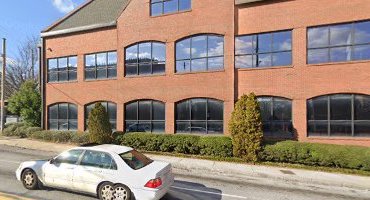Georgia Tech team helps integrate STEM in classrooms at M.R. Hollis Innovation Academy
Aug 7, 2018
Kevin Arne, Paulette Richards, Ryan Snelling, and Rachel Tierney have completed the first year of the Innovators-in-Residence program at M.R. Hollis Innovation Academy. The group worked for the Georgia Tech Center for Education Integrating Science, Mathematics, and Computing (CEISMC) as part of the academy’s partnership with CEISMC’s School and Community Engagement program.
During the 2017-18 school year, the innovators-in-residence helped STEM (science, technology, engineering, and mathematics) teachers at Hollis integrate technologies such as robotics kits and 3D printers into their classrooms.
For example, Snelling helped teachers run their own printers. Snelling is an aerospace engineer and member of Decatur Makers. “We showed them not only how to use tools like Tinkercad and Onshape to create designs,” he said, but also how to operate and use the printers in class and perform routine maintenance.
Tierney, an undergraduate studying computer science at Georgia Tech, helped develop a class project for an Earth Science class. Using a seismograph she made out of K’NEX pieces and Hummingbird Robotics Kits as a model, the students built their own devices. Because Tierney left the design to the students, “the seismographs all looked different, which was very cool,” she said.
Tierney also assisted the all-girls after-school program Technovation. She helped girls build their own apps using App Inventor. In May, the students presented their apps to information technology and marketing professionals at Chick-fil-A.
Georgia Tech alum and civil engineer Arne worked with a Hollis STEM teacher to develop a robotics activity for fifth and sixth graders, similar to the Discovery network series BattleBots.
“We came up with “SumoBots,” Arne said. It features two robots trying to push each other out of a ring. Unlike BattleBots, this style of robotics does not damage the robots or require frequent replacement of parts. Students can use higher quality controllers, “rather than having to patch together cheaper parts that may not work,” Arne said.
Meanwhile, Richards worked with the art teacher. A teaching artist herself, Richards learned that most K-12 students do not know how structures work. At Hollis, she assembled kits demonstrating cardboard construction techniques, which students applied to a project she likes to think of as “Art meets engineering.”
“Most of the houses in this neighborhood are craftsman bungalows,” Richards said. So she researched the craftsman movement and the features of typical craftsman houses. The art teacher presented the information to the students. Then, the students imagined what the houses could look like if they were renovated.
The students designed their renovations on architecture paper brought by two students from the Georgia Tech School of Architecture. “The kids really enjoyed drawing on that and working with the rulers,” Richards said. She saw that the students felt good about themselves when they managed to assemble and paint their cardboard houses according to their own vision.
All four innovators-in-residence worked on a final project based on the film Black Panther. Inspired by the use of wearable technology in the fictional Kingdom of Wakanda, the project incorporated art, 3D printing, and coding.
“We came up with this Wakandian fashion idea,” Richards said. She incorporated Black Panther’s use of West African symbols known as Adinkra by finding analogs for the six “Habits of Hollis” – Communication, Collaboration, Creativity, Empathy, Perseverance, and Self-Discipline.
In art class, the students used 3D-printed Adinkra stamps to transfer the symbols onto cloth panels. The panels were fashioned into costumes that incorporate brooches, which the students programmed to light up.
The Black Panther project encompassed cultural studies, design, and coding. "When you bring all that together, now you're seeing a much more real-world example,” Snelling said. “Multidisciplinary types of work are becoming more and more common. The best websites have graphic designers — so it’s not just code; it’s art. The more we build those kind of learning experiences, the more they directly translate into work you could be doing in the future.”
Rosemary Pitrone - CEISMC Communications
CEISMC is currently seeking four dynamic individuals for its 2018-19 Innovator-in-Residence cohort. If you are interested, please email your resume and a cover letter to Alba Gutierrez, Educational Outreach Manager, at alba.gutierrez@ceismc.gatech.edu.





